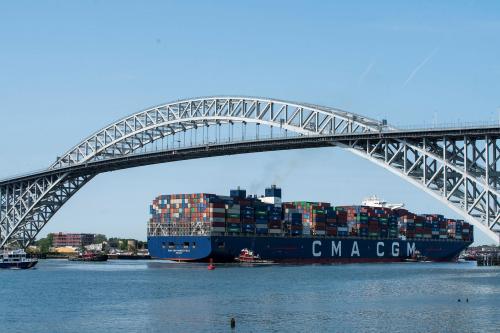The U.S. economy relies heavily on the global flow of goods — consumer, commercial, energy — across the ocean. That fact has been brought vividly to life by supply chain interruptions — in the Suez Canal and the Port of Long Beach — and their inflationary effects. True there are vital industries like finance and software that rely on the flow of data, not goods. However, over 90% of all data in the world flows through undersea cables that line the ocean floor. There’s no part of our prosperity that would not be adversely affected if ocean-based trade were impeded or slowed.
Securing that flow of trade has long been a primary mission of the U.S. Navy. Since the end of the Cold War the U.S. has enacted this mission largely alone, the only nation with a genuinely global navy. This crucial function adds weight to American influence in the workings of globalization, which redounds to U.S. profit — literally as well as diplomatically.
COUNTERING COMPETITION ACROSS THE PACIFIC
Enter the Chinese People’s Liberation Army Navy (PLAN). Evolving from a semi-partner to the U.S. in securing trade against Indian Ocean and Malacca Straits piracy, as well as a regional claimant; then, a complicating regional player; to now, a regional powerhouse with increasingly assertive policy, and a global claimant of growing capability.
The PLAN is the leading edge of Chinese militarization and feeds the development of the leading-edge technologies — like space-based communications — required for a blue water navy. For good reason: The baseline geopolitical fact of our time is that the world’s two most powerful countries are separated by thousands of miles of ocean — ocean waters that both sides want to dominate and secure, for commercial and strategic purposes. The core function of Chinese military modernization, as sagely assessed in a new U.S. Navy planning publication, is “… to reshape the security environment to its advantage by denying the United States military access to the western Pacific and beyond.” The cost, if they succeed, will be a serious decline in American commercial and diplomatic power, and an equal loss of freedom of maneuver in strategic terms.
The 2022 Navigation Plan (NavPlan) lays out nothing short of an ambitious blueprint for preserving American maritime dominance. Other U.S. armed services — notably the Marines — have already laid out some of their own required transformations for deterrence and warfighting against powerful competitors. The Air Force and the Army lag in laying out a credible vision for their role in the current threat environment. This document, coming from the Navy, is crucial, as many of the key tasks ahead are uniquely naval functions.
The NavPlan lays down the two essential missions: fielding the capacity and readiness for warfighting in unnamed but obvious seas to deter China (as well as Russia); and global maritime dominance — both to keep the sea-lanes open for trade, and to give the U.S. military flexibility unavailable to its competitors. This will require what the chief of naval operations (CNO) describes as a “combat-credible U.S. Navy — forward deployed and integrated with all elements of national power…”. This would allow the Navy to be consistently positioned in theater should conflict occur. Among an ongoing debate on the value of forward presence, the CNO argues persuasively in favor of combat-credible forward deployment — not simply presence for presences’ sake.
That’s going to take a larger fleet. The United States faces the mounting challenge of PLAN assertiveness in the western Pacific, potential second-stage Russian aggression in the regions bordering the Baltic Sea or Arctic Ocean, and the continuing challenge of securing globalization. To tackle all of that, simply put, requires a larger navy than the U.S. currently maintains. The CNO’s document lays down the design imperatives for such a fleet, setting out six needed elements: expanding the distance from which long-range precision fire can be launched, enhanced deception, hardened defenses, increased distribution, reliable delivery, and improved decisional advantage (involving naval information warfare). And, mindful of cost imperatives, argues that this can best be achieved in the context of a hybrid fleet, combining staffed, optionally staffed, and unstaffed ships — 500 of them, by the CNO’s design; 350 staffed and 150 unstaffed. The document goes on to lay out a specific force design to accomplish the goals. One can quibble with precise numbers of this or that class of ship or boat but the overall picture of a force more reliant on submarines, smaller ships, and hybrid platforms is convincing.
THE COST OF EXPANSIONS
A more difficult question is whether it’s affordable. By the CNO’s estimate, this fleet architecture will require spending of 3-5% above inflation in the coming years. By other estimates, it will take more than that, and abandoning the long-evolved norm of a three-way budget split between the major services. After 20 years of ground wars, the U.S. Navy is under-sized and under-equipped, and the U.S. can’t correct for that without shifting spending priority towards the Navy’s programs. Whether this document does enough to convince Congress of that imperative remains to be seen. But if fielding an adequate force to deter the PLAN isn’t the central goal of current military spending, what is? In a more than $773 billion annual defense budget, which tasks have greater priority?
Of course, the U.S. could reduce costs by choosing to have its navy focus narrowly on only the one mission, putting all its eggs in the basket of deterrence in the western Pacific. This, though, would leave U.S. and allied interests in Europe dangerously unguarded, and leave a major lacuna in the protection of global trade. The U.S. has recently experienced the steep costs of even minor interruptions to sea-based flows of good and energy; we are not prepared for larger, wider, longer interruptions. If America wants to deter China, and keep the global economy flowing, it needs a bigger navy. It’s as simple as that.
Another question, though, is: how fast? In an otherwise compelling document, there’s one jarring note, on the by when issue. This comes in the headline that marks the transition from strategy to planning. Before that headline, the document repeatedly — and convincingly — refers to “this critical decade” in the race to reshape capacity. But the section on force design and architecture is headlined by an effort to imagine the fleet in 2045. Twenty-plus years — more than double the time it took to wage the Spanish Civil War and World War II combined. The U.S. doesn’t have that kind of time.
Of course, the Navy leadership is aware of this; hence the tighter timeline in the rest of the text. Presumably the 2045 date is being used as a device to stimulate imagination, to break people out of current thinking. All well and good. But so is a sense of urgency. Perhaps best articulated in a recent speech by the chief of naval research, Rear Admiral Lorin Selby — whose clarion call for urgent imagination should be required listening for all Navy leaders.
Congressional leaders as well, especially those who are in position to authorize increased and more predictable funding for an expanded shipbuilding program. The CNO’s document points to the importance of the shipbuilding, maintenance, and logistics components of fielding a larger navy, though perhaps not quite with the emphasis it deserves. At present, even huge congressional largesse couldn’t produce the navy the United States needs — there simply isn’t adequate shipbuilding capacity in the country.
Of course, part of the issue of size and timelines is dependent on what capacity U.S. allies and partners can wield. The 2022 NavPlan correctly states that their capacity will be essential to succeeding in the stated missions. But it’s rather silent on how to incentivize the right set of investments by those countries. Our closest allies in Europe are grappling with a land war and the major economic/energy costs associated with that crisis, and our Asian allies lag far behind in terms of net capacity. Perhaps it is a question better posed to the authors of the National Defense Strategy — but there, at least in public version, the reference is simply to planning around allied capability, not incentivizing change. That won’t get us where we need to be. Part of the answer might lie in pushing more of the global trade protection mission onto allies; after all, their stake in securing globalization is even larger than ours. That could free up U.S. capacity for deterrence.
These critiques aside, this arguably is the best planning document from any service in recent years. The other services should emulate it, as should those agencies also essential for “integrated deterrence”, including State and Treasury. If they did, and if the Department of Defense budgeted and Congress funded these plans, America would be well begun on a path towards actual capacity to compete against other contending powers.
The Brookings Institution is committed to quality, independence, and impact.
We are supported by a diverse array of funders. In line with our values and policies, each Brookings publication represents the sole views of its author(s).










Commentary
Navigating great power competition – A serious planning start
August 3, 2022